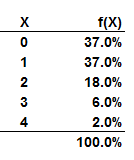Learning objectives: Describe and distinguish a probability mass function from a cumulative distribution function and explain the relationship between these two. Understand and apply the concept of a mathematical expectation of a random variable. Describe the four common population moments.
Questions:
20.3.1. Assume a continuous random variable over the domain {6 < X < 10} is given by f(x) = a*x where (a) is a constant; i.e., {f(x) = ax | x ∈ 6 < X < 10}. What is the Pr(X ≤ 8)? Bonus: what is the variable's expected value?
a. 19.53%
b. 43.75%
c. 50.00%
d. 56.25%
20.3.2. A discrete random variable is characterized by the probability mass function (pmf) as given by f(x) = x*a, and its domain is the set of integers {6, 7, 8., 9, and 10}. What is the variable's expected value?
a. 6.67
b. 8.00
c. 8.25
d. 9.33
20.3.3. Ralph is an analyst who wants to characterize a random variable with a discrete probability distribution where the only outcomes are {0, 1, 2, 3, and 4}. The Poisson distribution with a mean of 1.0 is a surprisingly good fit as it gives Pr(X = 0) = Pr(X = 1) = 36.8%. The problem with the Poisson is that it has a long tail such that the Pr(X ≥ 5) = 0.366%; for example, there is a very tiny possibility (1.0E-08) that the outcome could exceed ten given the Poisson's support is the entire set of natural numbers. To enforce a true probability distribution that is bounded at four, Ralph simply rounds the pmf densities and, due to sheer luck, when rounded (to two digits) the first five outcomes (including zero) sum exactly to 100.0%. The ensuing probability distribution is the following, which might be dubbed a "truncated Poisson" with λ = 1.0:

The exact mean (aka, expected value or weighted average) of this variable is 0.990, but let's assume its average is a round 1.0. What is the skewness of this variable?
a. -0.774
b. Zero
c. +0.830
d. +2.440
Answers here:
Questions:
20.3.1. Assume a continuous random variable over the domain {6 < X < 10} is given by f(x) = a*x where (a) is a constant; i.e., {f(x) = ax | x ∈ 6 < X < 10}. What is the Pr(X ≤ 8)? Bonus: what is the variable's expected value?
a. 19.53%
b. 43.75%
c. 50.00%
d. 56.25%
20.3.2. A discrete random variable is characterized by the probability mass function (pmf) as given by f(x) = x*a, and its domain is the set of integers {6, 7, 8., 9, and 10}. What is the variable's expected value?
a. 6.67
b. 8.00
c. 8.25
d. 9.33
20.3.3. Ralph is an analyst who wants to characterize a random variable with a discrete probability distribution where the only outcomes are {0, 1, 2, 3, and 4}. The Poisson distribution with a mean of 1.0 is a surprisingly good fit as it gives Pr(X = 0) = Pr(X = 1) = 36.8%. The problem with the Poisson is that it has a long tail such that the Pr(X ≥ 5) = 0.366%; for example, there is a very tiny possibility (1.0E-08) that the outcome could exceed ten given the Poisson's support is the entire set of natural numbers. To enforce a true probability distribution that is bounded at four, Ralph simply rounds the pmf densities and, due to sheer luck, when rounded (to two digits) the first five outcomes (including zero) sum exactly to 100.0%. The ensuing probability distribution is the following, which might be dubbed a "truncated Poisson" with λ = 1.0:

The exact mean (aka, expected value or weighted average) of this variable is 0.990, but let's assume its average is a round 1.0. What is the skewness of this variable?
a. -0.774
b. Zero
c. +0.830
d. +2.440
Answers here:
Last edited by a moderator:
